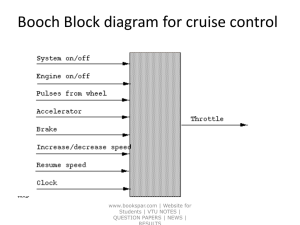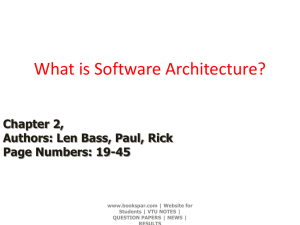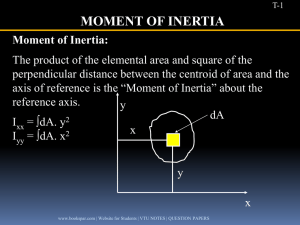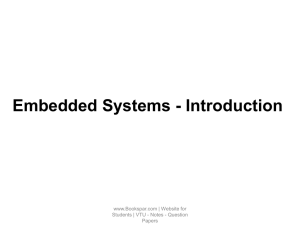Architecture Business Cycle
advertisement
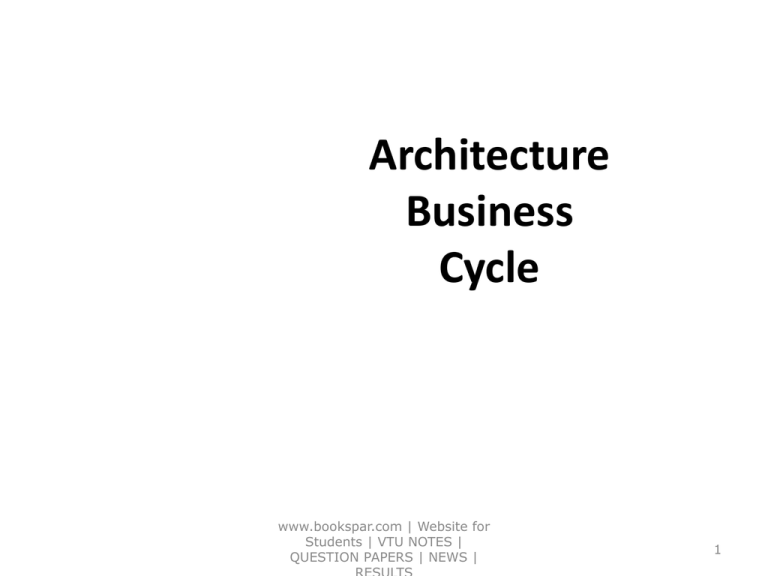
Architecture Business Cycle www.bookspar.com | Website for Students | VTU NOTES | QUESTION PAPERS | NEWS | 1 Software architecture.. • The architectural view of a system is abstract, distilling away details of implementation, algorithm, and data representation and concentrating on the behaviour and interaction of "black box" elements. www.bookspar.com | Website for Students | VTU NOTES | QUESTION PAPERS | NEWS | 2 Software Architecture Definition The software architecture of a program or computing system is -the structure or structures of the system, which comprise software elements, the externally visible properties of those elements, and the relationships among them. www.bookspar.com | Website for Students | VTU NOTES | QUESTION PAPERS | NEWS | 3 The Architecture Business Cycle (ABC) • Software architecture is a result of technical, business, and social influences. • Its existence, in turn, influences these technical, business, and social environments. • This cycle of influences from the environment to the architecture and back to the environment is called the Architecture Business Cycle. www.bookspar.com | Website for Students | VTU NOTES | QUESTION PAPERS | NEWS | 4 Where Do Architectures Come From? • Architectures are influenced by: –System stakeholders –The developing organization –The background and experience of the architects –The technical environment www.bookspar.com | Website for Students | VTU NOTES | QUESTION PAPERS | NEWS | 5 Developing organization management stakeholder Low Cost Marketing stakeholder End User Stakeholder Neat features, Short time to market, Low Cost Behaviour, Performance, Security , Reliability, Usability Maintenance organization stakeholder Customer stakeholder Modifiability Low cost, Timely delivery, not changed often www.bookspar.com | Website for Influence of system stakeholders on Architect Students | VTU NOTES | QUESTION PAPERS | NEWS | 6 ARCHITECTURES INFLUENCED BY SYSTEM STAKEHOLDERS • Acceptable system involves properties performance, reliability, availability, utilization, security, modifiability, interoperability with other system. such as memory usability, • The underlying problem, is that each stakeholder has different concerns and goals, some of which may be contradictory. • The reality is that the architect often has to fill in the blanks and mediate the conflicts. www.bookspar.com | Website for Students | VTU NOTES | QUESTION PAPERS | NEWS | 7 ARCHITECTURES INFLUENCED BY THE DEVELOPING ORGANIZATION Architcture is also influenced by the structure and nature of organisation. There are three classes of influence that come from the developing organization • Immediate business • Long-term business • Organizational structure (subcontract) www.bookspar.com | Website for Students | VTU NOTES | QUESTION PAPERS | NEWS | 8 ARCHITECTURES INFLUENCED BY THE BACKGROUND AND EXPERIENCE OF THE ARCHITECTS Architects for a system have had good results using a particular architectural approach, chances are that they will try that same approach on a new development effort, or may be reluctant to try it again. Architectural choices may also come from an architect's education and training, exposure to successful architectural patterns, or exposure to systems that have worked particularly poorly or particularly well – or to experiment also www.bookspar.com | Website for Students | VTU NOTES | QUESTION PAPERS | NEWS | 9 ARCHITECTURES INFLUENCED BY THE TECHNICAL ENVIRONMENT • Architect's background and experience is reflected by the technical environment • Current environment will influence the architecture– standard industry practices or software engineering techniques www.bookspar.com | Website for Students | VTU NOTES | QUESTION PAPERS | NEWS | 10 Ramifications Effect of the Various Influences on an Architecture • The properties required by the business and organizational goals are seldom completely understood. • Customer requirements are often not complete or well documented. • Architects must identify and actively engage stakeholders to solicit their needs and expectations. • In addition to technical skills, architects need to be skilled in diplomacy, negotiation, and communication. www.bookspar.com | Website for Students | VTU NOTES | QUESTION PAPERS | NEWS | 11 Influences on the Architecture www.bookspar.com | Website for Students | VTU NOTES | QUESTION PAPERS | NEWS | 12 Architectures affect the factors, that Influence them Relationship among business goals, product requirement, architects experience, architectures and fielded system form a cycle with feedback loop www.bookspar.com | Website for Students | VTU NOTES | QUESTION PAPERS | NEWS | 13 Architectures affect the factors, that Influence them • • • • The structure of the developing organization. The goals of developing organization. Customer requirements for the next system. The architect’s experience with subsequent systems. • The software engineering culture.(i.e technical environment ..) www.bookspar.com | Website for Students | VTU NOTES | QUESTION PAPERS | NEWS | 14 Structure of the developing organization • Architecture affect the structure of the organization • It prescribes the units of software to be implemented. • Development, test , integration. • Teams are formed for individual software unit. • Teams become the part of the organization structure. www.bookspar.com | Website for Students | VTU NOTES | QUESTION PAPERS | NEWS | 15 • Goals of developing organization • It enables a company to establish a strong foothold in the market area. • Architecture provides an opportunity for the organization to adjust its goal, so that it can take advantage from the market. www.bookspar.com | Website for Students | VTU NOTES | QUESTION PAPERS | NEWS | 16 Customer requirements for the next system • Architecture gives the customer an opportunity to receive a system that is more reliable, timely and economic than a system which is build from scratch. • The customer may be willing to relax some requirements to gain the economies. www.bookspar.com | Website for Students | VTU NOTES | QUESTION PAPERS | NEWS | 17 The architect’s experience with subsequent systems • It’ll affect the architect’s experience with subsequent systems by adding to the corporate experience base. www.bookspar.com | Website for Students | VTU NOTES | QUESTION PAPERS | NEWS | 18 The software engineering culture • A few systems will influence and change the s/w engineering culture i.e. the technical environment in which system builders operate and learn. www.bookspar.com | Website for Students | VTU NOTES | QUESTION PAPERS | NEWS | 19 Software processes and ABC Many activities are involved in creating SA, using that arch., to realize design and then to implement or manage the system. Software Architecture Activities are……… • • • • • • • Creating the business case for the system. Understanding the requirements Creating or selecting the architecture Documenting n Communicating the architecture Analyzing or evaluating the architecture Implementing based on the architecture Ensuring conformance to an architecture www.bookspar.com | Website for Students | VTU NOTES | QUESTION PAPERS | NEWS | 20 Creating the business case for the system • It is simple to create a business case than understanding the needs of market • How much should be the product cost? • What is the Targeted market? • What is the targeted time to market? • Will it need to interface other system? • Are there system limitations ? www.bookspar.com | Website for Students | VTU NOTES | QUESTION PAPERS | NEWS | 21 Understanding the requirements • There are variety of techniques to understand requirements from stakeholders. Object oriented analysis: use cases & scenarios • Safety Critical Systems: • Finite state machine models • Formal specification languages • Quality attributes • Prototypes Regardless of technique used, -the desired qualities of the system to be constructed determine the shape of architecture. www.bookspar.com | Website for Students | VTU NOTES | QUESTION PAPERS | NEWS | 22 Creating or selecting the architecture • Conceptual integrity • A small no. of minds coming together to design the system’s architecture. www.bookspar.com | Website for Students | VTU NOTES | QUESTION PAPERS | NEWS | 23 Communicating the architecture For effective architecture • It must be communicated clearly and unambiguously to all stakeholders. • Developers must understand work assignments. • Testers must understand the task structures • Management must understand the scheduling implications www.bookspar.com | Website for Students | VTU NOTES | QUESTION PAPERS | NEWS | 24 Analyzing or Evaluating the architecture • Out of multiple designs, after analyzing, some design will be accepted or some are rejected. • Evaluating an architecture for the qualities it supports is essential to ensure the stakeholders satisfaction (needs). • Scenario- based techniques are for evaluation of architecture. www.bookspar.com | Website for Students | VTU NOTES | QUESTION PAPERS | NEWS | 25 Implementing based on the architecture Concerned with keeping the developers faithful to the structures. Should have an environment that assists developers in creating the architecture. Ensuring conformance to an architecture Finally, when an architecture is created and used, it goes into maintenance phase. Constant vigilance is required to ensure that actual architecture and its implementations remain faithful to www.bookspar.com | Website for each other. Students | VTU NOTES | QUESTION PAPERS | NEWS | 26 What Makes a ‘Good’ Architectural Process? Given the same technical requirements for a system, two different architects in two diff. orgns, will produce different architectures. Then how to decide which is right one ? Rules of thumb/observations that should be followed when designing an architecture. These are divided into two clusters: 1. Process recommendations www.bookspar.com | Website for 2. Product(structural) recommendations . Students | VTU NOTES | QUESTION PAPERS | NEWS | 27 • • • • • • Process recommendations are:(The architecture) be product of a single architect or small group of architects. gather both the functional requirements and a well specified, prioritized list of quality attributes. be well documented, with at least one static view and one dynamic view. be reviewed by the system’s stakeholders. be analyzed for applicable quantitative measures and formally evaluated for quality measures. develop a “skeletal” system to facilitate incremental implementation. www.bookspar.com | Website for Students | VTU NOTES | QUESTION PAPERS | NEWS | 28 The structural rules of thumb are: • The architecture should feature well-defined modules based on the principles of information hiding and separation of concerns. • Each module should have a well-defined interface that hides changeable aspects. • Quality attributes should be achieved using wellknow architectural tactics. • The architecture should be independent of particular versions of commercial products or tools. • Modules that produce data should be separate from modules that consume data. www.bookspar.com | Website for Students | VTU NOTES | QUESTION PAPERS | NEWS | 29

